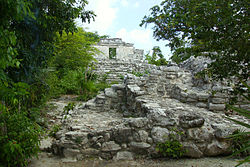Xcaret (Maya)
Coordinates: 20 ° 27 ′ 0 ″ N , 87 ° 18 ′ 0 ″ W.
Xcaret (Polé) is a Maya ruin site in the Mexican state of Quintana Roo , on the east side of the Yucatán Peninsula on the Caribbean coast.
geography
The ruins of Xcaret are located about 5 km south of Playa del Carmen , directly on the Carretera federal 180 , which connects Cancun in the north with the capital Chetumal .
Xcaret belongs to the Municipio Solidaridad . Part of the historical site is now located on the grounds of the private amusement park of the same name .
The Maya settlement was formerly called Polé , probably derived from p'ol - to do business . Today it is almost exclusively called Xcaret . The name Xcaret means narrow inlet and refers to a small stream that flows here.
Before the Konquista , Polé or Xcaret belonged to the principality of Ekab . Xcaret was very probably the connection port to the directly opposite island of Cozumel with its nationally known cult site of the goddess Ix Chel . The place played an important role in the network of Caribbean coastal trade, together with El Meco and El Rey in the north and Xel Há , Tancah / Tulum and Muyil in the south.
history
The first traces of settlement can be found from the Early Maya Classic (250–600 AD). Most of the buildings date from the Middle to Late Post- Classical period (1200–1500 AD).
From around 1200 AD, Xcaret developed into a prosperous port and trading point due to the dwindling influence of the centers of power inland. The city was part of the coastal trade network that ran along the Caribbean coast with a large number of locations and promoted the region economically. This shows the erection of numerous residential and cult buildings as well as a wall, probably to protect the buildings near the coast from attacks from the sea.
As a port and local coastal center, Xcaret was probably closely related to important inland cities, particularly neighboring Cobá . The extent to which it served as a trading port for Cobá is unclear.
After the arrival of the Spaniards on this stretch of coast, the place gradually depopulated, but in contrast to other coastal ports, it remained inhabited until modern times.
Polé is mentioned in one of the Chilam Balam's books in connection with the mythical journey of the Itzá .
building
The core area of the settlement consists of a number of building complexes along the coastline. They are listed in alphabetical continuously as Group A to Group K named.
Group A is slightly raised in the south of the bay outside the walled area. It consists of about ten structures. The buildings represent the typical east coast style.
Group B , just a few meters to the west, consists of five structures, mostly low platforms. They form two architectural units.
Group C is located about 100 m northeast of the bay and comprises four structures and bases for smaller residential buildings in the east coast style.
Group D , 80 m north-west of Group C, is slightly elevated on the surrounding wall. From here the coast could be seen well. The main structure has a semicircular base with a well-preserved temple, also in the east coast style.
In group E , with the most important complex, are the two tallest buildings of Xaret, No. III and IV. During the excavations, relics from the Early Maya Classic (250–600 AD) were discovered, which suggest a use as a Indicate ceremonial area.
Group F , 250 m northeast of Group E on a large platform, consists of three east coast style buildings. One of them is a temple with two ledges, each showing three elements indicating its importance.
Group G , 20 m south of Group F and about 150 m from the coast, is a 16th century chapel. With the chapels in Ecab and Tancah it is one of the first evidence of the Spanish presence in Mexico. During the excavations carried out by María José Con Uribe in 1994, 135 graves of Spaniards, Mayans and mestizos were found in the atrium. The archaeologists found fragments of cotton fabric on the buried.
Group H , 500 m northeast of the bay, includes a single temple and a low platform with a smaller temple; they are near a cenote .
Group K is on the other side. It consists of two separate temples.
The wall eventually runs from Group A to Group E between the buildings and the beach. Unlike in Tulum, where the buildings are enclosed by a wall on the land side, it is most likely, as in Xel Há, a protective wall against attacks from the sea. Some researchers see this as a feature of the unsafe living conditions that prevailed in the Caribbean coastal region at the time.
See also
Individual evidence
- ↑ INAH Archaeological Site Xcaret (Spanish) ( Memento from August 30, 2009 in the Internet Archive )
Web links
- Zona Arqueológica Xcaret. In: www.inah.gob.mx. January 21, 2016, accessed March 10, 2016 . (Spanish).


